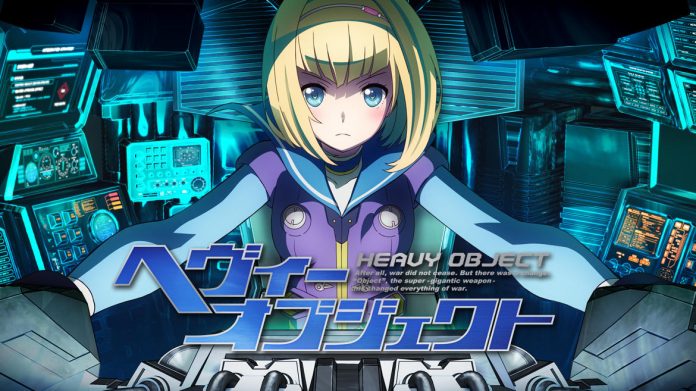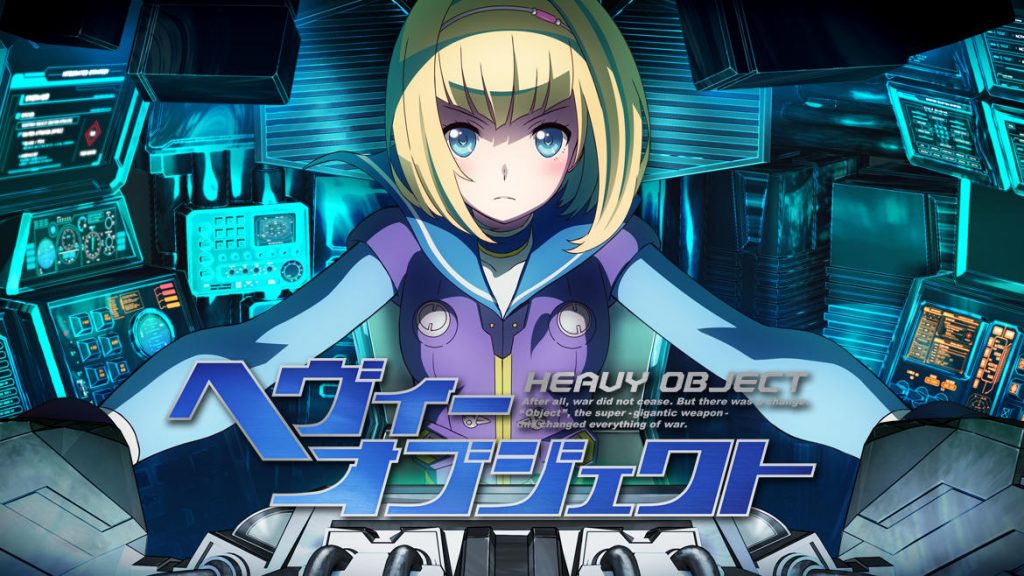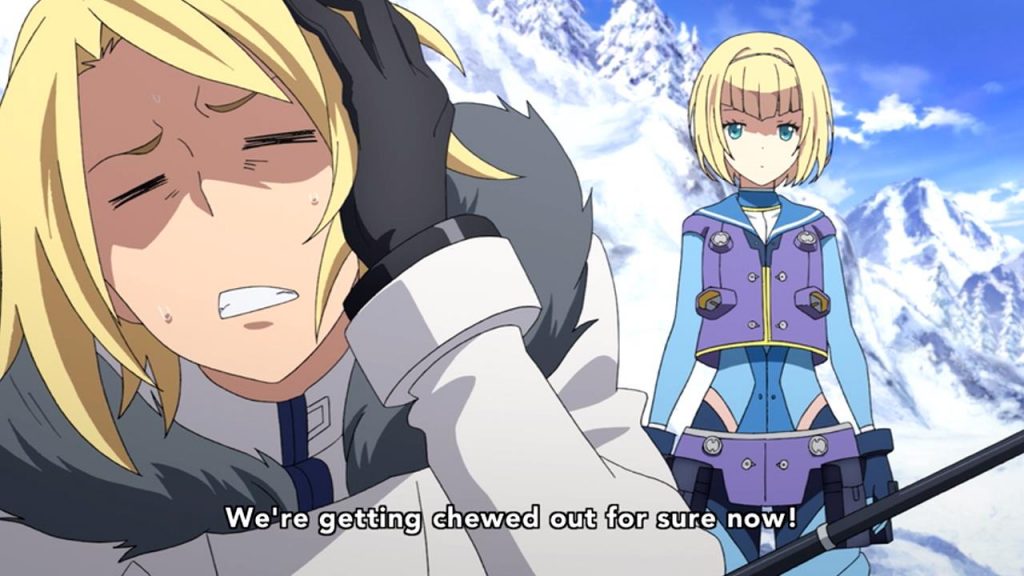I never fancied myself as a military otaku fan. When looking at stereotypical military otaku fans, I don’t fit in. I’m not big on weapons, nor do I typically enjoy first person shooter video games (with a few exceptions). However, I always seem to add more and more military anime to the list of anime I like. I enjoyed watching GATE, Izetta: The Last Witch, in addition to Saga of Tanya the Evil (among other titles). So I come across Heavy Object, which is right up my alley when it comes to military anime. Add the fact that the author of Heavy Object was written by the same one (Kazuma Kamachi) who wrote A Certain Magical Index; I was all too eager to review this series. Knowing how much I love A Certain Magical Index left me wondering if this show could break through as a great mecha series.
In the world of Heavy Object, the concept of war has drastically changed. Huge mechanized battle machines, called Objects, dictate which country has power. The more Objects your country has, the more power it holds. That means skirmishes are decided rather quickly with no casualties, considering the destruction of an Object ends the battle. This is how the world works until our main heroes alter the status quo by destroying Objects by themselves.
I give this series a lot of credit for starting out the way it did. Usually, I’m used to studios going all out on the first episode to try and make it as memorable as possible, with production quality dipping toward the end. However, Heavy Object didn’t do that, and instead kept things consistent throughout all 12 episodes. Most anime fans follow the three to four episode rule, and I believe Heavy Object did enough to draw people in, due to the first mission taking up three episodes. It gave fans everything they asked for, with humor, solid robot action, and a little fanservice. This makes Heavy Object a series that more people would stick with, rather than drop. In the first arc, our main heroes (Qwenthur and Havia) try to do the impossible and disarm a mighty Object by themselves (a task that many would call suicidal). They end up surviving a bloody battle, save the main heroine (Princess Milinda). Qwenthur and Havia believe that their heroics would allow them to move up in the ranks, but they are instead used as secret weapons to help other war fronts that are having trouble with an enemy Object.
Besides the action that you get in this series, I became quite a fan of the buddy-cop relationship that Qwenthur and Havia had. Their discussions were funny, but what made it so remarkable was that neither was an idiot. Havia may have had some questionable interests when it came to women, but he showed his intelligence when the chips were down during battles. The two were enjoyable to listen to as they were discussing their plans to try and do the impossible. Not to be outdone, both Milinda and Frolaytia were also intelligent characters, making the main cast great to watch. I prefer smart characters as a personal preference, and Heavy Object didn’t disappoint.
Surprisingly, this series has an element of realism that I did not expect. Viewers get to see realistic elements of war and politics. Some examples of these include politicians using war to keep their image clean and get re-elected. Or military forces that are slaughtering their people to put the blame on others and gain sympathy with the world. Plus, there were many monologues about how ugly war can be, instead of making it seem like a fun field trip, as it is sometimes depicted. While Heavy Object isn’t as brutal as Saga of Tanya the Evil, it’s commentary about war certainly gives the series a dark cloud. Even the infantry battles were surprisingly violent, with blood-splattering head shots (I screamed in shock when I first saw it). While many moments were funny and happy, adding both real and dark tones was a big plus.
But I think the scariest part about this series is how this world, portrayed as chaotic and splintered as it is, isn’t so far off from reality today. Take away the Object’s mobility (as well as the designs), and you pretty much have a nuclear missile being piloted by elites. The Objects clearly are a symbol of a weapon of mass destruction (WMD). After all, countries with the capabilities and resources to make the largest amount of WMD’s hold a lot of the power in the world. The threat of this type of weaponry is used as leverage to try and keep other countries in check, exactly like Objects are used in this world.
While I enjoyed this anime, as a fair warning, Heavy Object is heavy on explaining things. Qwenthur and Havia leave no detail out when explaining the geopolitical scene, their missions, or assessing the situation they were involved in completing. The jargon can leave people scratching their heads and possibly need to replay a scene or two to get what is going on. Having an engineering background myself, I found this to be a charm since you rarely have series explain things in much detail. It gave the series more legitimacy as to how Qwenthur and Havia destroyed Objects (especially in episode 5). I found so much pleasure in Qwenthur and Havia’s success in destroying Objects, proving that you don’t want to mess with engineers like Object patience workers.
I think it’s because of all of all the explanations that I found the pacing of the show just right after 12 episodes. Heavy Object didn’t rush through any of their arcs, which I liked. Knowing how much dialogue was needed, as well as mixing in the strategy in battles, gave the series a nice flow throughout. I never felt that anything was rushed; Heavy Object was allowed to develop at the right pace. None of the battles were simply a confused mess of Objects firing at one another. There was a backstory as to why an individual battle was happening, and a lot of time for a countermeasure to be made by our heroes.
You might think that after all the praise I’ve given it, that this anime is nearly perfect. However, that’s not the case. After finishing the first 12 episodes, you could have changed the name of the series to Heavy Fanservice. The amount of it that was thrown in front of viewers got to an alarming level. Scenes such as Frolaytia sitting across our main heroes, purposefully showing off the front of her panties, left a pretty bad mark on the series. That was something that wasn’t needed at all, and it diminishes her character the more it occurred. And sadly, that wasn’t the only time. Frolaytia’s body has been made a mockery in Heavy Object, thanks to the demeaning (even if it was meant as good-hearted fun) remarks about her over the military communication systems, and also in the scene where Qwenthur sexually assaults her by grabbing her breasts. Breasts being grabbed is a normal occurrence in anime. After all, there is the development of a harem aspect with Qwenthur as we reach the final episode in this release. However, having this happen between a cadet and his C.O. was totally inappropriate. Due to the setting of the war and military, it gave me an all-too-bad taste in my mouth that brought the series down.
Milinda was also not immune to the fanservice shoved in front of viewers as well. Scenes like Qwenthur playing the flute, with it connected to her senses, or having to cool down naked in the cockpit of an Object—It was just unnecessary to have as much of this for me to take it seriously. It had a great premise, action, and story, so why add as much fanservice as they did? And then there is the final scene:
Why was this needed, in an anime that more or less tried to be serious? Instead, I was left scratching my head at the overall message this series was trying to convey.
I didn’t like how the last episode (episode 12) ended as well. It was just as bad as what you get in Gundam Unicorn (the television series). As soon as Qwenthur finishes assaulting Frolaytia (and she stomps on his face), she just smiles and seems to like the fact that he cares about her enough to help her get out of a marriage proposal. Then the episode ends right after her line. It gave me the same sensation I get from slamming the brakes in a car. Knowing that this series is 24 episodes, this isn’t a huge issue, but considering that the first set ended on that abrupt note, it was certainly jarring.
I also would have liked more Object on Object battles, instead of just focusing on Qwenthur and Havia trying to stop the object (and defeat the odds). It became formulaic, but the different Objects that were in battle, as well as the environment, gave enough variety not to be a huge issue. I’m just hoping that in the second part we get more Object versus Object matches just to give viewers what battles were like before Qwenthur and Havia flipped the world upside down. The Objects themselves were distinct from what I’m used to in mech anime, so seeing more of them would be a nice change compared to just watching our heroes use explosives.
inally, I could have used a little more information about the world in which our heroes reside. Hearing Milinda talk about a mock battle that she would have to take part in was especially fascinating. Apparently elite families participate in mock battles to raise their status and worth. I wouldn’t mind knowing more about how the world is split so much, as well as how things are being governed. That little speech gave a small window into what this world is like, but I could use more information to get a better grasp as to what is going on.
The dub cast did a solid job in dubbing this series, which is impressive considering Heavy Object received a broadcast dub while it premiered. I wasn’t entirely blown away from everyone’s performance, but I wasn’t disappointed or discouraged by any of the actors. I would give the nod to both Morgan Garrett (Frolaytia) and Micah Solusod (Havia) as the more impressive performances. Both gave a ton of emotions in scenes that were needed and made the characters feel real. But the entire cast did do an excellent job.
The product itself is a standard FUNimation release with a cardboard slipcover. It also comes with two commentaries (one audio and one video), and I highly recommend watching the video commentary. It was a funny episode to pick, and the actors seemed to have a blast just talking to each other about working on it among other topics.
In the end, I’m left scratching my head about Heavy Object. It has some remarkable highs, as well as some great and climactic moments. However, the heavy fanservice prevalent in this series brought the overall product down. I know that A Certain Magical Index had quite a bit of fanservice, but it didn’t leave as bad of an impression as Heavy Object did. The action that was in the first part was surprisingly violent, and the commentary on what the real world is like was a huge plus. I give Heavy Object a favorable rating on the premise that the second half will improve on what the first half was doing. (Interesting enough FUNimation has posted the entire series subbed on it’s YouTube page).
Rating 7/10
Pros: Commentary to the real world; the Objects; the main characters; Qwenthur and Havia buddy cop dynamic.
Cons: Heavy Fanservice that was terribly uncomfortable at points; abrupt ending to this set; can put fans off with all the explaining done.
C.J Maffris is an editorial writer for Toonami Faithful and GeekeInc.com. He enjoys fanservice as much as the next fan but does have a limit. Feel free to follow C.J on Twitter @SeaJayMaffris



